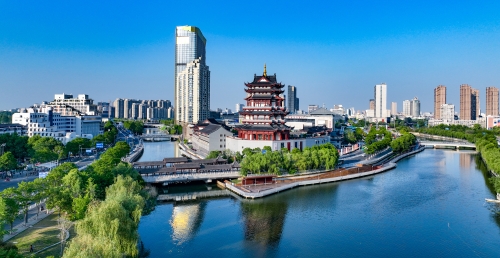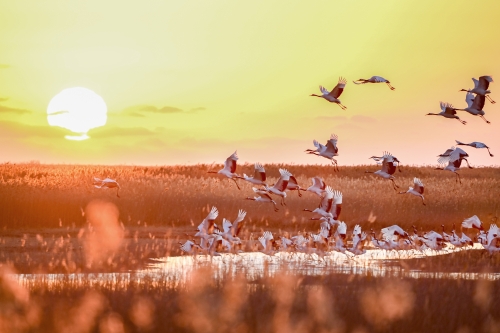Yancheng City ( 32°34′-34°28′N and 119°27′-120°54′E),located in the central coastal area of Jiangsu Province, borders the Yellow Sea on the east, Nantong City and Taizhou City on the south, Huai’an City and Yangzhou City on the west, and Lianyungang City to the north separated by Guanhe River. Yancheng City, a prefecture level city with the largest territory and the longest coastline in Jiangsu Province, boasts unique and abundant resources of land, marine and tidal flat. Its total land area is 17,700 square kilometers, including an area of 4,553 square kilometers of coastal tidal flat which accounts for 70% of the coastal tidal flat area of the entire Jiangsu Province.And its coastline is 582 kilometers long, accounting for 56% of the total coastline length of Jiangsu Province.
Yancheng is one of the earliest areas turning from sea to land. The sea and land of the city have undergone several changes. About 20,000 years ago, the current city was all land. About 7000 years ago, the warmer climate and a large-scale transgression made the current city all sea, becoming part of the shallow bay. A large amount of sediment brought by the Yangtze River and the Huaihe River gradually accumulated at the bottom of the shallow bay, forming an off coast sandbank from northwest to southeast. In the second year of Jianyan of the Southern Song Dynasty (1128), the Yellow River took over the Huaihe River’s channel to enter the sea. After more than 700 years, a huge amount of sediment brought by the Yellow River met with the sediment moving northward from the Yangtze River Estuary. Then the coastline of Yancheng rapidly extended eastward, and the sea gradually became land.

Yancheng is rich in natural resources, including ocean and mudflat resources, coastal port resources, oil and gas resources, ecological tourism resources and other natural resources.
Yancheng’s planned port shoreline along the coast is 129.2 kilometers including 64.9 kilometers of deep water shoreline, and 33.3 kilometers of port shoreline has been utilized. Its internal water area is 12,100 square kilometers, and territorial sea area is 6,753 square kilometers, being China's only red tide-free inland waters. Yancheng Port includes Dafeng Port, Sheyang Port, Binhai Port and Xiangshui Port. The ore in Yancheng is of low grade mainly including clay ore, geotherm, mineral water, oil and gas. Yancheng is rich in eco-tourism resources. In the eastern part of the city, there is the largest coastal wetland on the west coast of the Pacific Ocean and the edge of the Asian continent, which is listed as the world’s key wetland reserve. In the protection area of the wetland, there is the world’s first wild David’s deer reserve and national rare bird nature reserve, and it is a member of the United Nations Man and the Biosphere Programme.The western part of the city is located in the hinterland of the Lixia River area, and the water area of Dazong Lake, Jiulongkou, Majiadang and other lakes is nearly 100 square kilometers, which are typical lagoon-type lake wetlands.The original ecological environment is well preserved, known as “golden beach and silver lake”.

Before the Western Zhou Dynasty, this was home to Huaiyi tribes. In the fourth year of Emperor Wu of the Han Dynasty (119 BC), Yandu County was founded. In the seventh year of Emperor An of the Eastern Jin Dynasty (411), it was renamed Yancheng because of the salt farms around the city. In September 1941, Yanfu District Administrative Office was established. Yancheng was divided into 3 counties of Yancheng, Yandong, Jianyang while Funing was divided into 2 counties of Funing and Fudong. In January 1953, the Jiangsu Provincial Government was established, and the Yancheng Special Area had jurisdiction over 8 counties of Yancheng, Dongtai, Dafeng, Jianhu, Sheyang, Funing, Binhai and Huai 'an. In March 1983, the new system of city administering county was implemented, so Yancheng Special Area and Yancheng County were abolished, and Yancheng City was established under the jurisdiction of Jiangsu Province. At present, it has jurisdiction over 1 county-level city of Dongtai, 5 counties of Jianhu, Sheyang, Funing, Binhai and Xiangshui, and 3 districts of Yandu, Tinghu and Dafeng. There is also Yancheng Economic and Technological Development Zone and Jiangsu Yannan High-tech Industrial Development Zone (Yancheng Chengnan New District was changed into Jiangsu Yannan High-tech Industrial Development Zone in June 2019).
5. History and culture
With a long history, Yancheng is one of the earliest places in the coastal area of eastern China which started development. In the Neolithic Age about 6000 years ago, the ancestors on this land worked hard and gave birth to ancient civilizations of Yancheng. As Yancheng locates along the sea, the ancestors made full use of geographical advantage to “boil salt out of sea water” during the Warring States Period.
During the Qin and Han dynasties, within this territory, people got profits from boiling salt out of sea water and transported the salt through canals. Salt and iron industry were quite developed with a relatively large population and common usage of iron tools and cattle farming. In the 4th year of Yuanshou (119 BC) in Emperor Wudi’s reign, part of the coastal of eastern old Sheyang County was set up as a new county.
In the seventh year of Yixi of Emperor An of the Eastern Jin Dynasty (411 AD), Yandu was renamed Yancheng because “Salt sites were scattered in the city” and the name matched the reality as the city grew and prospered owing to salt. For a long time, Yancheng led the salt industry in fields of technology, production, quality. Yancheng is known for the culture of sea salt and the culture underpinned its civilization.
Yancheng has rich cultural endowment and great humanities. Chen Lin, one of the seven leading writers during the Jian’an period was famous both at home and abroad. In the Song Dynasty, Yan Shu, Lyu Yijian, and Fan Zhongyan successively served as salt officials in Xixi, and later became officials for the royal families. Fan Zhongyan, who wrote “Feel worried before the world starts to worry; and feel happy after the world has rejoiced”, required to build the sea dyke during his term as the salt official in Xixi. In order to pay respect to Fan Zhongyan, the dyke is now called as “Fangong Dyke”.
Lu Xiufu, the Prime Minister of Southern Song Dynasty,sacrificed his own life for the country and became a national hero. During the end of the Yuan Dynasty and the beginning of the Ming Dynasty, the literary giant Shi Nai’an and his apprentice Luo Guanzhong lived in the Baiju secretly and wrote the classic novel “Water Margin” and “The Romance of the Three Kingdoms”. More talents have lived here during contemporary times, such as the Buddhist Gao Henian, the calligrapher Gao Ershi, the educator Chen Zhongfan, the outstanding diplomat Qiao Guanhua and the well-known Marxism theorist Hu Qiaomu, also renowned as the “the most prestigious secretary in the CPC” for his writings.
(City introduction excerpted from http://www.yancheng.gov.cn/col/col1657/index.html)

